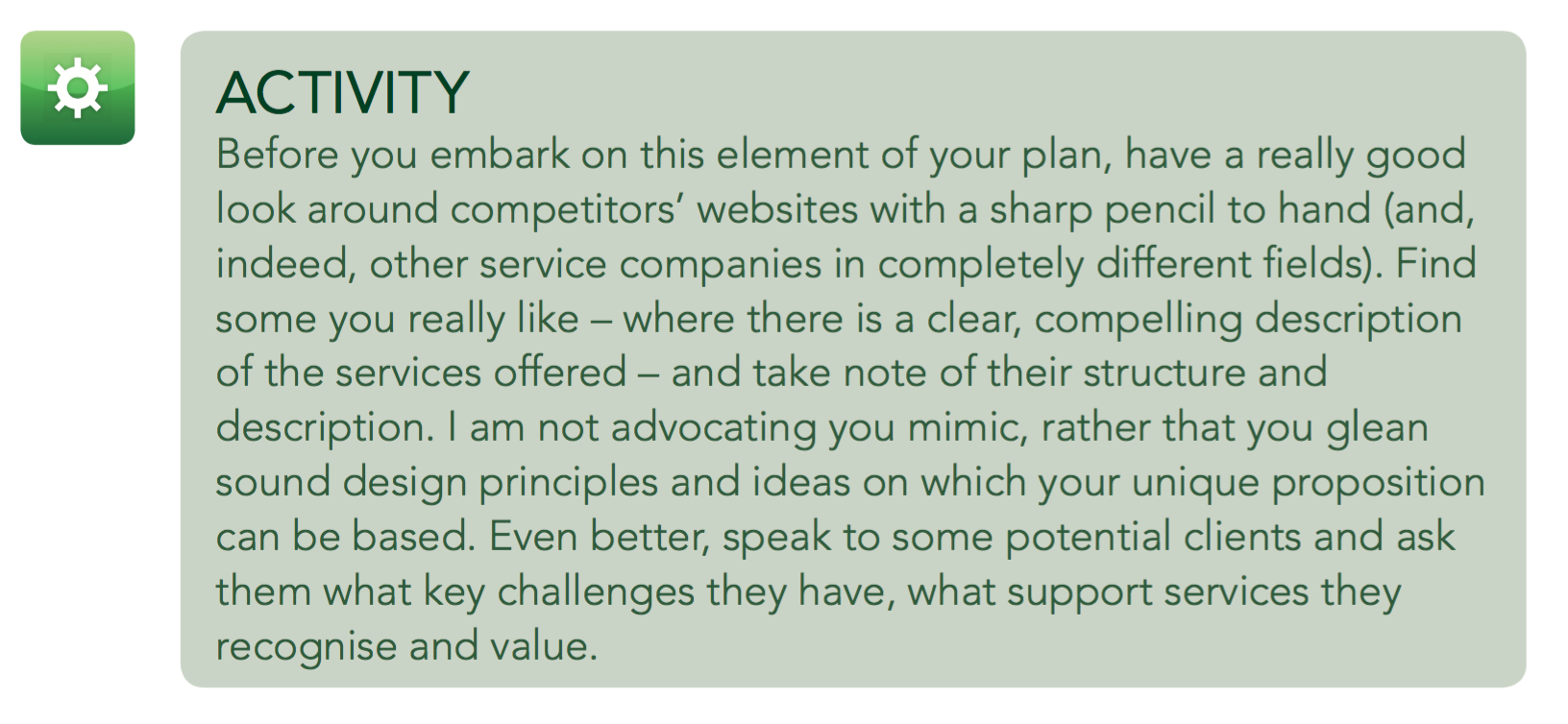Building your service proposition framework
Following on the series of business planning related blog posts (including ‘What a good business plan looks like?’ and ‘Developing a Business Planning Process’) this post looks at a key element of your plan: your company’s service proposition framework.
Another crucial area of pre-consideration when putting your business plan together is the services you plan to offer. As your successful firm grows and develops, so your service propositions will, inevitably, grow and adapt also. This is less, therefore, about defining a static offering but more about the initial foundation suite on which your company’s core, early marketing messages are based.
The skill in this regard is to address the question through the eyes of your potential clients; to have real proximity and empathy with the client requirement you meet, the anxiety you help salve, in the context of their situation, constraints and language. Language is really important. You have to be able to communicate your services in a form that is meaningful to them.
The other key skill here is that of structural design and formatting. Probably, you have the potential to offer an array of services but do you package this as one holistic offering or a set of twenty, modular items? This is worth some thought. I would encourage you to provide some decomposition as this, clearly, increases both the choice a client has and the chance of a connection moment (when they see/read/hear about your services and it really resonates with their situation). Too much breakdown and you risk confusing your audience; they might not be able to ‘see the wood for the trees’. ‘What exactly do these guys and girls stand for?’, they will ask. Similarly, if the development of your services becomes too wide, and you are perceived as offering ‘all things to all people’ you will quickly lose your audience. Clients value specialism. In some instances, as scale demands, the big client might seek the big firm that can offer the one-stop shop set of services across the globe. The market is very wary, however, of the small start-up that seeks to project an over-blown, bland, generalist statement of this ilk. By structure, I also mean that your services are best presented within an overall narrative or framework – which makes sense to your potential client base. For example, you provide a number of services mapped to the start-to-finish lifecycle of a typical client situation (e.g. diagnosis, solution development, solution build, capability development/handover etc); alternatively, they might be mapped to different industry sectors (e.g. accountancy support for veterinary practices, accountancy support for dentists etc) or just represent a coherent set of related skills (e.g. brand strategy, brand development, web design/build and digital marketing).
So, in summary, this section of your plan should put forward a digestible, relevant set of services within a rational, easily communicable framework. A good way of presenting the specific service modules is to capture for each:
- The typical client anxiety/need you are addressing.
- The actual service proposition that addresses this.
- Potential resources/tools/IP used in the service.
- Description of what a typical service intervention might look like.
- The benefits for a client who experiences this service.
————
If you are interested in re-charging your business ambition/strategy/plans, Dom runs his (three-day) Five-Year Entrepreneur Retreat twice a year – see here for previous delegate testimonials and details on future presentations. If you would like to make a reservation (capped to 14 attendees per Retreat) please drop a line via the contact page.
DOWNLOAD GUIDE 03 (BUSINESS PLANNING) HERE >>>





Hi Dom. another clear and practical post thank you. Can I ask what is your view on avoiding modularity vs the structure that you point to above? Its clear that client’s today want a specialist service who can build X capability in their organization, demonstrate value (via billing structure – not time) and exit. In my experience and research, there is a degree of fatigue amongst clients with consultants all over their business churning out modules that are common in the market place. I am seeing this movement in NYC particularly. What are your thoughts?
Hi Graham. My thoughts are … that time spent designing and structuring your service propositions is time very well spent. If offerings are ‘common in the market place’ then, by definition, they will instil client fatigue. Leading firms will, conversely, think very carefully about what it really is that makes them truly different – and ensure such aspects are well articulated. My post was also seeking to address a couple of sloppy practices I often see on professional service firm literature/websites. By ‘modular’, I mean there is some sense of structured logic in how you present your offerings cf. an arbitrary list. When I see the latter I always infer that the consultants are not rigorous in their own practices/methods (per Minto’s classic pyramid principle). Another common mistake is to position these offerings in a way that is very esoteric or “clever clever” cf. using language that clients readily recognise as addressing actual issues they are facing.
In summary, well done, a menu of service options should have granularity (to maximise the number of interest “hooks” that can spark the first BD conversation – without drowning/confusing), structure (to help the client read the set – and to reflect your own mental/logical practices) and good copy (that resonates with clients).
As an aside, I totally concur with the observation that clients want real specialism and a genuine focus on capability development/transfer.
Hopefully helpful.
Many thanks Dom – very helpful!